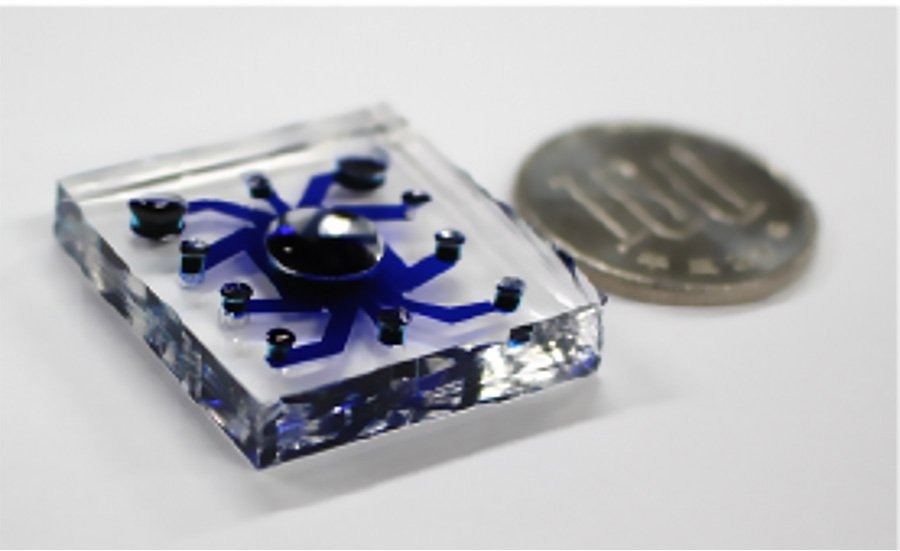Reviewed by Alex SmithNov 9 2022
Two distinct scientific problems, the high cost of drug development and the constraints of examining physiological processes in the lab, might have the same solution.
 A team of scientists has developed an electrochemical sensing platform for studying in vitro vascular systems. The channels and reservoirs were visualized using blue ink. Image Credit: Hitoshi Shiku
A team of scientists has developed an electrochemical sensing platform for studying in vitro vascular systems. The channels and reservoirs were visualized using blue ink. Image Credit: Hitoshi Shiku
Microphysical systems (MPSs) are in vitro platforms composed of cells in a microenvironment that closely resembles that found in the body. These platforms enable scientists to replicate the circumstances of tissues found within the body for applications like drug testing in a more accurate model than animal testing.
However, the inability of MPSs to precisely record what is happening at the cellular level has limited the advancements they could offer. Scientists have now created an electrochemical sensing platform that might address this problem.
On October 29th, 2022, the findings were released in Biosensors and Bioelectronics.
Recent bioengineering techniques have realized a construction of tissue model integrated with a perfusable vascular network. However, to utilize the models as drug screening tools, we need biosensors to monitor their functions in real-time, which until now were lacking. This study developed new electrochemical sensing platform to monitor the vascularized tissue model.
Yuji Nashimoto, Study Corresponding Author, Tokyo Medical and Dental University
The team determined that electrochemical sensors, with their low invasiveness, real-time detection, and high sensitivity for in vitro culture platforms, are the best choice for reading out cell functionality.
However, the researchers note that due to their incompatibility with microfluidic devices, integrating electrochemical sensors into MPSs has proven to be challenging.
To measure oxygen metabolism in 3D tissues with a vascular flow that resembles that of the human body, the researchers were able to blend their sensing platform for 3D cultured cells with a perfusable vascular network. This is an engineered vascular system that allows fluid to pass through it.
This seamless integration was made possible partly by the system’s design, which included an open top, a lower layer with five channels for expanding the vascular network, and an upper layer for growing 3D cultured cells and analyzing oxygen metabolism. A thin membrane existed between the two layers.
Using fibroblast spheroids from the human lung, the researchers tested the platform. The oxygen metabolism changes caused by drug administration through the vascular network were then assessed using it on a cancer organoid. The results indicated that their sensors were effectively incorporated into the framework to deliver the desired precise measurements.
We found that the platform could integrate a perfusable vascular network with 3D cultured cells, and the electrochemical sensor could detect the change in oxygen metabolism in a quantitative, non-invasive, and real-time manner.
Hitoshi Shiku, Study Corresponding Author, Graduate Schools of Engineering and Environmental Studies, Tohoku University
Shiku stated, “Biosensors are very important tools to realize more physiological drug screening. Our research group has developed various sensors for the purpose. We continue to expand the detectable molecules and to develop more robust and high-throughput sensors.”
The advancement of a perfusable vascular network in an even more controlled environment than is currently possible, together with how to address the changes of the spheroid and organoid during device culture, should all be addressed in future studies, according to the researchers.
The findings of this study hold promise for observing perfusable vascular networks for drug testing purposes in a way that has not yet been accomplished, even though the researchers identified the following steps for future studies.
“This study developed oxygen metabolism analysis for the vascularized tissue model. In the future, the detectable molecules should be expanded, and the signal-to-noise ratio should be improved,” Shiku further added.
Journal Reference:
Nashimoto, Y., et al. (2022) Electrochemical sensing of oxygen metabolism for a three-dimensional cultured model with biomimetic vascular flow. Biosensors and Bioelectronics. doi:10.1016/j.bios.2022.114808.